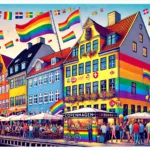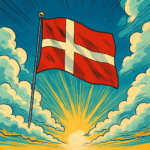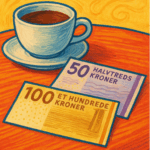Origins and the “-sen” Tradition
In Denmark, a last name often tells a simple story: where your ancestors lived or whose child you were.
Take Dahl, which comes from the Old Norse word dalr (“valley”), or Holm, meaning “small island.” But the vast majority of Danish surnames end in -sen, which literally means “son of.”
Until the mid-1800s, Danes didn’t have fixed family names. Instead, a child’s surname changed every generation.
If your father was named Hans, you’d be Hanssen (“son of Hans”); if he were Niels, you’d be Nielssen. Daughters had a parallel ending, -datter, meaning “daughter of.” So Hans’s daughter would be Hansdatter.
In 1856, a Danish naming law froze patronymics into permanent surnames.
That’s why you still see piles of common Danish surnames ending in -sen, while -datter has virtually disappeared. In 2006, Denmark even relaxed its laws to let parents choose new patronymics again—though very few use it.
Getting an insight into this naming law clarifies why Danish surnames end in -sen: it’s a snapshot of that 19th-century legal shift that captured centuries of patronymic habit in one fell swoop.
Why “-sen” Names Dominate
Here are a few explanations for why popular Danish surnames all look so similar:
- Patronymic Roots
- Almost every Danish name ending in -sen meant “son of” your father’s given name.
- Examples: Jensen (“Jens’s son”), Nielsen (“Niels’s son”), Hansen (“Hans’s son”).
- Naming Law of 1856
- Before: Each generation got a new surname.
- After: Surnames became hereditary, so the most common Danish last names stayed fixed.
- Scandinavian Pattern
- Similar laws in Norway and Sweden produced names like Johanssen, Olsen, and Andersson.
- Denmark’s twist: keeping -sen while almost erasing -datter.
- Modern Consistency
- A 2006 update lets parents pick new patronymics, but most Danes stick with what they know.
- Today’s phonebook still reads like a who’s who of traditional Danish surnames.
Table of the Top 20 Surnames and Their Meanings
Below is a detailed table of Denmark’s twenty most frequent surnames, their literal translations, and a note on any non–-sen outliers:
| Rank | Surname | Literal Meaning | Notes |
|---|---|---|---|
| 1 | Jensen | Jens’s son | Jens = Danish form of Johannes |
| 2 | Nielsen | Niels’s son | Niels = Danish from Nicholas |
| 3 | Hansen | Hans’s son | Hans = short for Johannes |
| 4 | Pedersen | Peder’s son | Peder = Peter |
| 5 | Andersen | Anders’s son | Anders = Andrew |
| 6 | Christensen | Christen’s son | Christen = Christian |
| 7 | Larsen | Lars’s son | Lars = Laurence |
| 8 | Sørensen | Søren’s son | Søren = Latin Severinus |
| 9 | Rasmussen | Rasmus’s son | Rasmus = Erasmus |
| 10 | Petersen | Peter’s son | Peter = “rock” |
| 11 | Jørgensen | Jørgen’s son | Jørgen = Danish George |
| 12 | Madsen | Mads’s son | Mads = Mathias |
| 13 | Kristensen | Kristen’s son | Kristen = Christian variant |
| 14 | Olsen | Ole’s son | Ole = Scandinavian Olaf |
| 15 | Thomsen | Thomas’s son | Thomas = “twin” |
| 16 | Christiansen | Christian’s son | — |
| 17 | Poulsen | Poul’s son | Poul = Paul |
| 18 | Johansen | Johan’s son | Johan = John |
| 19 | Knudsen | Knud’s son | Knud = knot (Old Norse) |
| 20 | Mortensen | Morten’s son | Morten = both Martin & Maurice |
(Source: Forebears.io)
Notice two things: 1) Twenty out of twenty follow the “X’s son” formula, and 2) even the outlier non–-sen names (Møller, Lund) reflect simple, everyday origins: millers and groves.
Famous Danes with Staple Surnames
These names aren’t just for everyday Danes—in fact, some of Denmark’s biggest names bear these patronymics:
- Hans Christian Andersen
The writer of The Little Mermaid and The Ugly Duckling literally was Andersen—“son of Anders.” His fairy tales helped put Denmark on the world map. - Carl Nielsen
Denmark’s most celebrated composer. His surname Nielsen (“son of Niels”) ranks second on our list. - Ole Kirk Christiansen
Founder of the LEGO Group. Christiansen was one of the first in his family to fix “Christian’s son” as a lasting surname—ironically the same impulse that made LEGO bricks stick together forever. - Lars Løkke Rasmussen
Former prime minister. Rasmussen (“son of Rasmus”) shows up in the top ten and demonstrates that even politicians carry these humble patronymics.
These household names remind us that common Danish surnames aren’t “common” in any pejorative sense—they’ve graced world-renowned artists, entrepreneurs, and statesmen alike.
Beyond “-sen”: Occupations and Places
While Danish family names lean heavily on patronymics, a handful stem from jobs or geography:
- Møller (“miller”): Someone who worked at a mill.
- Lund (“grove”): A family living near a small wood or grove.
- Vestergaard (“west farm”): A farm on the western side of a village.
- Bjerregaard (“hill farm”): A farm by a hill.
These exceptions remind us that ancestral occupations and landscapes also left their mark. If your name is Møller, you likely had a miller in your lineage; if you’re Lund, your ancestors dwelled near a grove of trees.
Søren Kierkegaard’s very name echoes a slice of Danish landscape:
Kierkegaard (modern spelling: Kirkegaard) literally means “churchyard” or “church farm” (from kirk(e) “church” + gård “yard/farm”).
It’s a fitting reminder that even Denmark’s greatest existential thinker carried a surname rooted in place – linking him, in name, to the quiet grounds where community and contemplation have long met.
A Quick Note on Danish Naming Laws
- 1856 Law: Made patronymics permanent. No more new -sen or -datter each generation.
- 2006 Update: Loosened restrictions, allowing parents to revive patronymic names—but uptake remains tiny.
For those curious about the mechanics of these laws, the National Archives of Denmark offers detailed overviews of how Danish naming conventions evolved—see their guide here.
Why It Matters for Genealogy and Travel
- Genealogy: If you’re tracing a Danish branch of your family tree, recognize that every Hansen, Jensen, or Nielsen you find may not be closely related—those names could spring from hundreds of different Hans, Jens, or Niels.
- Travel: Spotting names ending in -sen on a hotel register or restaurant menu tells you you’re in authentic Danish territory. You’ll also find Danish surname street signs and heritage plaques peppered across Copenhagen, Aarhus, and beyond.
- Culture: Understanding that a name like Petersen simply meant “Peter’s son” grounds you in Denmark’s convivial, down-to-earth approach to identity—no aristocratic “von” or “de” here.
A Name Is More Than Just a Label
Next time you meet a Dane named Andersen, Larsen, or Kristensen, you’ll know you’re looking at a living piece of history.
Each popular Danish surname carries a fragment of a story: of a son named after his father, of a family who worked the mill, or of a homestead by a grove.
These names have stuck around for centuries because they connect us—to our ancestors’ occupations, to the laws that shaped modern Denmark, and to a shared Scandinavian tradition.
These Danish surnames carry centuries of history and community spirit.
With this insight, every “-sen” you encounter becomes a gateway to Denmark’s rich heritage—so go forth and discover the stories etched into each name. Velkommen til Danmark!







Good https://is.gd/N1ikS2
Awesome https://is.gd/N1ikS2
Very good https://is.gd/N1ikS2
Good https://is.gd/N1ikS2
Good partner program https://shorturl.fm/N6nl1
Awesome https://shorturl.fm/oYjg5
Good partner program https://shorturl.fm/N6nl1
Cool partnership https://shorturl.fm/FIJkD
Good https://shorturl.fm/FIJkD
https://shorturl.fm/a0B2m
https://shorturl.fm/bODKa
https://shorturl.fm/6539m
https://shorturl.fm/m8ueY
https://shorturl.fm/68Y8V
https://shorturl.fm/oYjg5
https://shorturl.fm/f4TEQ
https://shorturl.fm/Xect5
Join our affiliate program and watch your earnings skyrocket—sign up now! https://shorturl.fm/O95oe
Unlock exclusive rewards with every referral—enroll now! https://shorturl.fm/yzDwO
Share our products and watch your earnings grow—join our affiliate program! https://shorturl.fm/gnSo4
Your audience, your profits—become an affiliate today! https://shorturl.fm/gZKet
https://shorturl.fm/8JqGM
https://shorturl.fm/0SOOy
https://shorturl.fm/b9uNl
https://shorturl.fm/j8o1A
https://shorturl.fm/DbXOS
https://shorturl.fm/OUadl
https://shorturl.fm/dEhpP
https://shorturl.fm/l5Gzd
https://shorturl.fm/nHH3I
https://shorturl.fm/29aSe
https://shorturl.fm/2vMEE
https://shorturl.fm/cisyC